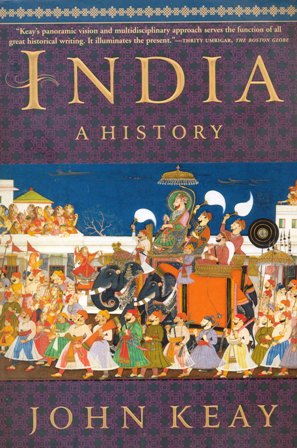-
India: A History
The Indian subcontinent is one of the world???s most fascinating and complicated regions, the home of a billion and a half people, several major religions, and one of the world???s oldest and most richly diverse civilizations. In India: A History, acclaimed South Asia expert John Keay spans five millennia in a sweepingnarrative that tells the story of the peoples of the subcontinent, from their ancient beginnings in the valley of the Indus to the events in Pakistan, India, and Bangladesh today. This book is a compelling epic of cultures and conquest, colonization and independence. It vividly re-creates the turning points of Indian history and brings to life the leaders who shaped India???s evolution, from Ashoka, the ???Caesar of Ancient India,??? who ruled the vast Mauryan empire in the third century B.C., to twentieth- century figures such as Mahatma Gandhi and Jawaharlal Nehru. Along the way Keay provides fresh insights into the patterns of invasion and migration that have stirred the subcontinent???s cultures for centuries, from the ???Aryan??? invaders, to Alexander???s Macedonian armies, to the Islamic conquerors, to the coming of the East India Company and the establishment of the British Raj. He also profiles the rise of religions and philosophies that have profoundly shaped these cultures, including Hinduism, Buddhism, and Islam. Throughout the book Keay synthesizes recent revelations from archaeology, anthropology, and textual scholarship to explode the myths that have plagued the highly politicized historiography of the region. He investigates the controversy surrounding the origins of the Harappan peoples who built the first cities of the subcontinent, explains the cultural and political significance of India???s architectural marvels such as the Taj Mahal, and details the bloody suppressions that characterized the ???Pax Britannica??? of the Raj.Provocative, comprehensive, and highly readable, India: A History is a panoramic portrait that is destined to become the authoritative work on the region for years to come.
-
The Spice Route
The Spice Route is one of history's greatest anomalies: shrouded in mystery, it existed long before anyone knew of its extent or configuration. Spices came from lands unseen, possibly uninhabitable, and almost by definition unattainable; that was what made them so desirable. Yet more livelihoods depended on this pungent traffic, more nations participated in it, more wars were fought for it, and more discoveries resulted from it than from any other global exchange. Epic in scope, marvelously detailed, laced with drama, "The Spice Route spans three millennia and circles the world to chronicle the history of the spice trade. With the aid of ancient geographies, travelers' accounts, mariners' handbooks, and ships' logs, John Keay tells of ancient Egyptians who pioneered maritime trade to fetch the incense of Arabia, Graeco-Roman navigators who found their way to India for pepper and ginger, Columbus who sailed west for spices, de Gama, who sailed east for them, and Magellan, who sailed across the Pacific on the exact same quest. A veritable spice race evolved as the west vied for control of the spice-producing islands, stripping them of their innocence and the spice trade of its mystique. This enthralling saga, progressing from the voyages of the ancients to the blue-water trade that came to prevail by the seventeenth century, transports us from the dawn of history to the ends of the earth.


